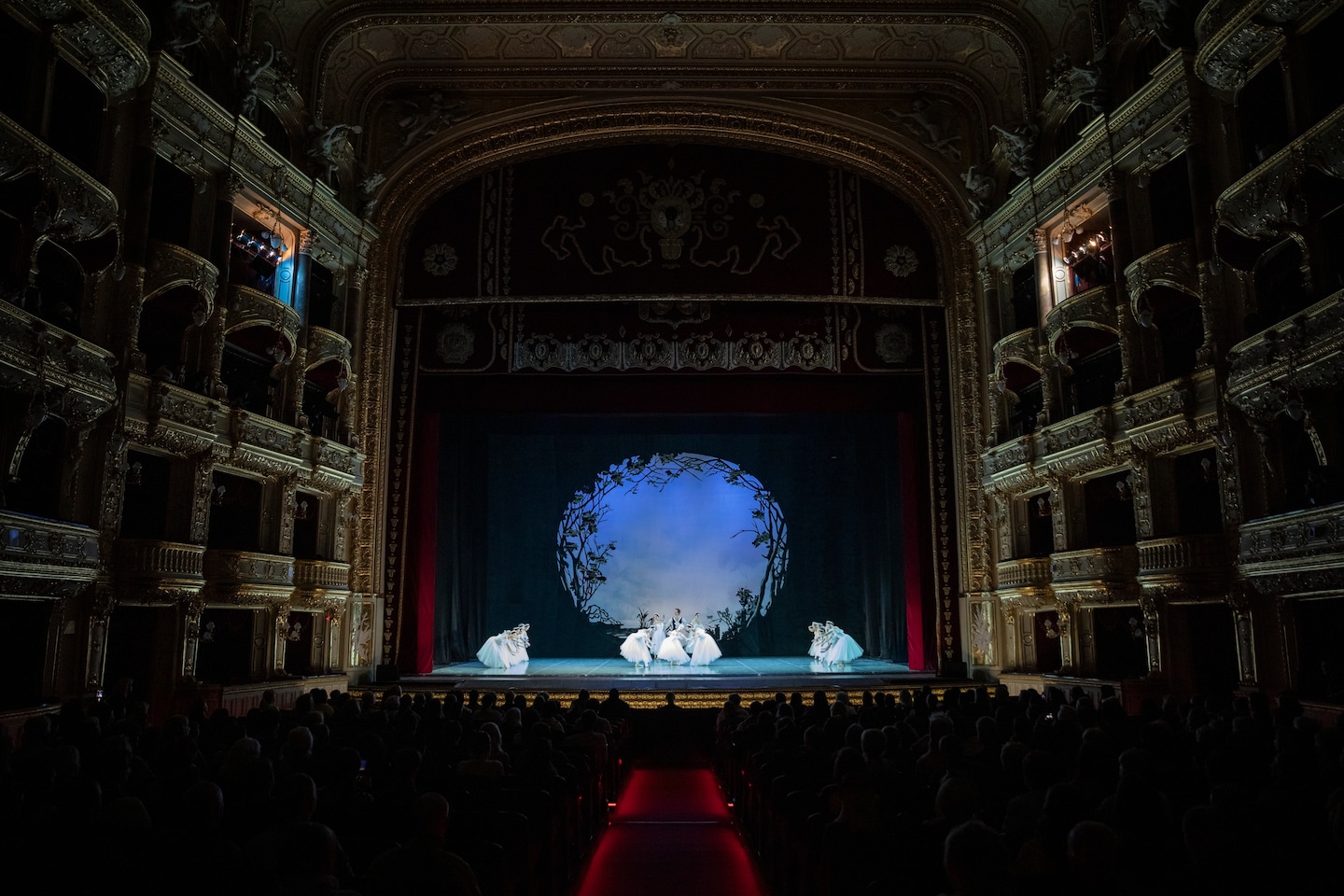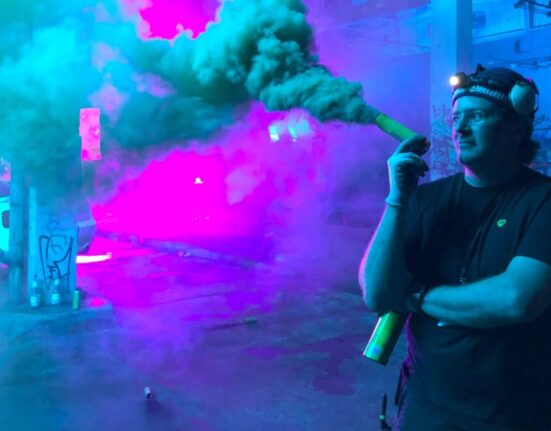She forgot about her beloved friend, Rostislav Yanchishen, who traded his ballet slippers for combat boots in February 2022 and became one of dozens of artists slaughtered in a war that will soon drag into its third year.
She forgot. But only for a moment.
Vorobiova, 42, finished her pirouette. The main stage lights flicked on, sweeping away the shadows. It was mid-December, less than an hour before the start of “Les Sylphides” — yet another performance without him.
On her last visit to his hometown, Yanchishen had confided in Vorobiova — a principal dancer at the opera — that he only wanted fresh flowers at his funeral. She remembered that he once starred in a ballet about a dying soldier.
“Ideas materialize,” she’d scolded him. “Don’t get yourself killed.”
He died in April, a month shy of his 32nd birthday.
There were so many like him. While the exact number is unverified, PEN Ukraine — a freedom-of-expression advocacy group — says at least 79 “people of culture” have been killed so far, each death tearing at the country’s cultural fabric and advancing Russian President Vladimir Putin’s efforts to deny Ukraine’s identity and future.
“Every artist is doing something which nobody else can do,” said Volodymyr Yermolenko, the president of PEN Ukraine. “Every killed artist makes Ukrainian culture less rich, more poor.”
There was the writer found in a mass grave in the woods, his war diary dug from beneath a cherry tree in his garden by another writer, who later died of injuries from a Russian missile attack on a pizza restaurant.
There was the filmmaker who chose his profession as his military call sign and died of a shrapnel wound to the head. There was the nature photographer who documented the changing seasons of a heart-shaped island near his home — pale with snow in winter, green come spring — killed rescuing a colleague.
The sculptor turned rifleman. The ballet soloist turned grenade launcher. The conductor turned front-line soldier.
Vorobiova stepped into the wings, where another ballerina was grinding her pointe shoes in rosin, ribbons trailing in the powder. A worker mopped the stage in slow circles.
Act I: ‘What will we be left with?’
The actor returned to his beloved theater in a casket.
About 150 people bunched outside the Theater on Podil in Kyiv, waiting in line on a sidewalk scraped of ice. Above the entrance, Vasyl Kukharskiy, 42, was pictured on a banner supporting the military. Before he was a soldier, Kukharskiy was a film star. Directors penned scripts with him in mind, eager for his safe return.
The hearse arrived. Soldiers draped a flag over the casket, then carried it down a staircase and into the theater, where he once performed. The room filled with winter coats and military green. Roses collected in Kukharskiy’s casket. His chest bloomed red.
His mother hunched over him as his father looked anywhere but down. He glanced at a slide show on the wall — his boy in costume, his boy onstage, his boy alive. He blinked, then reached into the casket to adjust the cross around his son’s neck.
People spoke of what was lost. They questioned what it meant.
“What will we be left with after this war, both in the film industry and in the theater environment?” the country’s top casting director, Alla Samoilenko, said later.
The morning waned. Soldiers carried Kukharskiy into the afternoon gray. His wife followed, trailed by the crowd. The theater was soon empty again.
Three days later came another funeral for another actor.
Act II: Flowers in the trenches
The Odessa Fine Arts Museum had finally reopened after November’s shelling, and Borys and Natalia Aizenberg were ready to see their son’s art again.
Out front, the entrance remained cordoned off with tape. A missile hit near the museum — a UNESCO World Heritage site — the night before a planned celebration of its 124th anniversary, shattering windows and shaking art from the walls. It is one of more than 330 cultural sites, UNESCO found, to be damaged or destroyed in the war. The building closed for a month of repairs.

Over 300 culturally important
sites have been damaged
Damaged UNESCO World Heritage site
Illegally annexed
by Russia in 2014
Sources: Post reporting, UNESCO (data as of Dec. 12), ISW
LAUREN TIERNEY/THE WASHINGTON POST

Over 300 culturally important
sites have been damaged
Damaged UNESCO World Heritage site
Illegally annexed
by Russia in 2014
Sources: Post reporting, UNESCO (data as of Dec. 12), ISW
LAUREN TIERNEY/THE WASHINGTON POST

Over 300 culturally important sites have been damaged
Damaged UNESCO World Heritage site
Illegally annexed
by Russia in 2014
Sources: Post reporting, UNESCO (data as of Dec. 12), ISW
LAUREN TIERNEY/THE WASHINGTON POST
Now, it was Dec. 18. Borys, 78, and Natalia, 79, entered by a side door and walked to the front gallery, where their son still felt alive. Here, the room erupted with wildflowers — poppies dappled with dew, dandelions unfurling yellow. The watercolors were mounted on wood salvaged from ammunition boxes. It was the idea of their 42-year-old son, also named Borys Aizenberg.
If Natalia scanned one of the gallery’s QR codes, she could hear his voice again, hear him talk about the fragility of nature and the atrocity of war, hear him explain, “We are here so you can live wherever you are.”
As commander of a rifle battalion, he led his soldiers much as he ran his family’s plant nursery — firm but gentle. He was known for his makeshift bouquets, placing buds in vases of sawed-off water bottles. He often painted in the trenches, the light dim, explosions roaring overhead.
After helping liberate the regions of Mykolaiv and Kherson, he died in July in Bakhmut rescuing an injured soldier. The previous month, for his mother’s birthday, he gifted what would be his final painting — a few blue and purple flowers. Now there would be no more art.
She reached out to touch one of the paintings, where Alpine flax kissed the horizon, never to wilt and fade.
Act III: ‘Have compassion’
Bohdan Bunchak survived the war only for the art within him to die.
Back home in Kyiv, he pulled up the cellphone videos recorded at the front. He still had an artist’s eye then, the compulsion to create. In one, the forest shimmers with fire, pines yellow-lit against a dark sky, set ablaze by shelling. He thumbed the screen. In the next, he recites Psalm 90, bullets coughing around him. A walkie-talkie, a toothbrush and a laminated Bible verse are tucked in his flak jacket.
“How long will it be?” he recites. “Have compassion.”
Bunchak, 28, was once a digital artist — a creator of multimedia videos swirling with archival footage, set to music composed by friends. Art guided him through college and to residencies across Europe — most recently in Frankfurt last fall.
Duty called him to the war.
A blast in July nearly paralyzed him, severing nerves in his spine. A squad commander, he had been on the front just 11 days. He relearned to stand, to walk. He graduated from a wheelchair to a walker to a cane. His legs spasmed. He had no feeling below his right knee.
Trauma occupied the spaces that art once filled. He adjusted his aching legs and played another video. He is in a vehicle with fellow soldiers, their green-helmeted heads stacked behind him like eggs in a carton. Once, he would have made something of it all.
Now, Bunchak said, “I think about art less and less each day.”
It was a few minutes until show time.
At the opera house, Vorobiova took her place onstage. Perched on a knee, she extended her left leg, toe pointed, encircled by a green tutu made of the same material as a bridal veil. She knew she was lucky to be working. Dancers who fled Ukraine had left the profession.
Beyond the orchestra pit, she heard the audience rustle — children fidgeting, soldiers talking of the day’s training, their row clouded with the scent of nicotine. She hoped the air raid sirens would stay quiet, that the evening would not end in the bomb shelter.
Again, she thought of Rostislav.
Vorobiova took a deep breath. She lifted her arms.







